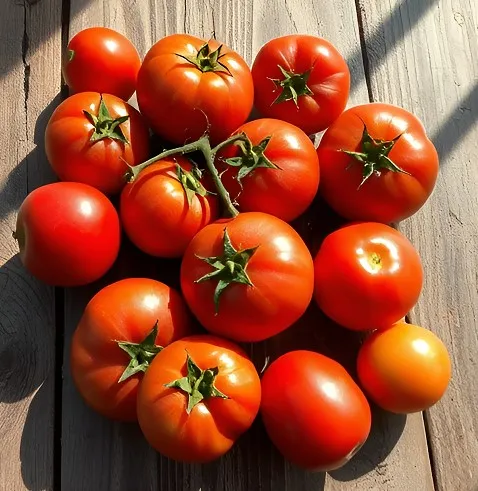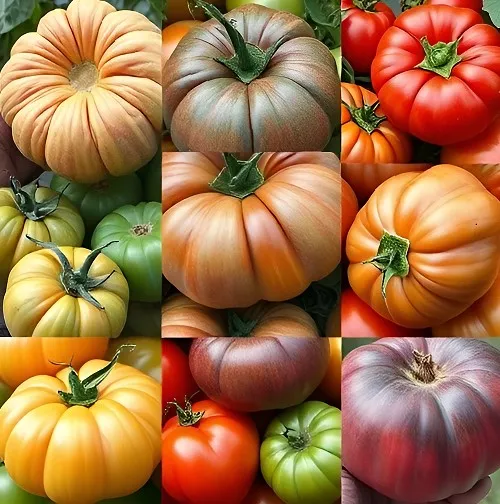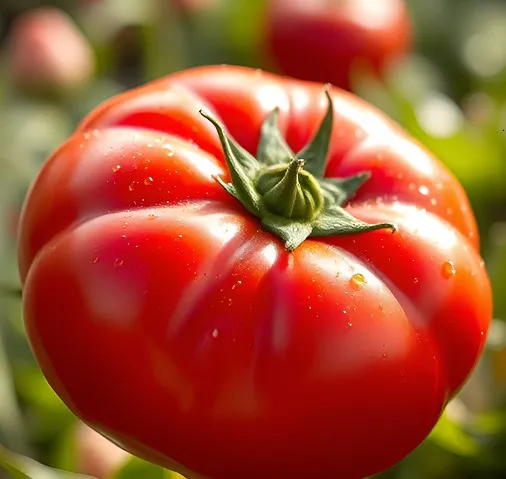Ever bitten into a juicy tomato and thought, “Wow, this is incredible?” If so, you’ve probably experienced the joy of a beef tomato. These giants of the tomato world, which are often called beefsteak tomatoes, aren’t just bigger; they pack a ton of flavor and have a unique texture that makes them a favorite for many. In this article, we’re going to journey through the wonderful world of beef tomatoes, from understanding what makes them special to growing your own and enjoying their deliciousness in various ways. So, if you are curious about the differences between different types of tomatoes, or just want to learn how to grow these garden beauties, you’ve come to the right spot. Get ready to get all the details you need to know about this fruit!
Table of Contents
What is a Beef Tomato? Understanding the Basics
Defining
What precisely is a beef tomato, then? Well, it has nothing to do with the flavor being beefy! In actuality, its huge size and mushy texture are what give it its name. These tomatoes are distinguished by their size, frequently weighing one pound or more each, making them larger than the typical salad tomato , they were designed to have particular traits, such as their size and deliciously meaty interior. Consider them to be the “kings” of the tomato patch. Additionally, because of their size and juiciness.

Key Characteristics
Now, let’s get into the specifics. Beef tomatoes usually have a flattened, slightly ribbed shape. But this can vary, depending on the variety. Inside, they are packed with thick, juicy flesh with fewer seeds than other tomato types. This makes them perfect for slicing and adding to burgers or sandwiches. Moreover, beef tomatoes tend to have a rich, sweet flavor with a touch of acidity. The skin is often a deep red, but again, this differs depending on the variety you grow. Some varieties even come in shades of pink, yellow, or even purple! In addition, you can find that they are known for having a slightly meaty texture.
Beef Tomato vs Regular Tomato: Size, Shape & Texture Differences
You might be asking, “How is a beef tomato really different from just a regular tomato?” The most obvious difference, as I’ve said, is size. A regular tomato is, well, regular – usually small and round. A beef tomato can be two, three, or even four times as big! Besides, shape differs, too. Regular tomatoes are more round, while beef tomatoes tend to be more flattened and irregular. And, while both are great, the texture is noticeably different. Regular tomatoes can be quite juicy but with a lot more seeds and a softer flesh. On the other hand, beef tomatoes have that signature firm, meaty flesh that makes them stand out. So, while both are wonderful in their own way, the beef tomato certainly carves out its own niche.
Varieties : A Gardener’s Guide
Popular Varieties: A List
When it comes to beef tomatoes, you’re spoiled for choice! There’s a whole world of different varieties out there, each with its own unique characteristics. So, let’s go through a few popular options.
- Brandywine: This is one of the most well-known heirloom beef tomato varieties. It’s famous for its fantastic flavor, often described as rich and slightly sweet. Additionally, Brandywine tomatoes usually have pinkish-red skin and a slightly irregular shape.
- Mortgage Lifter: A truly impressive beef tomato, Mortgage Lifter is huge, often weighing well over a pound each. Moreover, it’s known for its mild flavor and is very popular among gardeners.
- Big Rainbow: For those who like a pop of color, Big Rainbow is a great choice. These tomatoes are large and beautifully striped with yellow and red, which makes them visually appealing. Furthermore, they have a sweet, mild taste.
- Cherokee Purple: This variety offers a very unique flavor, often described as smoky and sweet. Its dark, almost purplish color also makes it stand out. Besides that, its texture and taste are remarkable.
- Costoluto Genovese: A beautifully ribbed beef tomato from Italy, this one has a robust, slightly tangy flavor that’s fantastic in sauces and salads. Additionally, its unique shape adds a touch of elegance to any dish

Choosing the Right Beef Tomato Variety For Your Garden
Choosing the right beef tomato variety can be tricky. Therefore, you need to consider your personal preferences. Firstly, think about the flavor you’re looking for. Do you like something sweet, tangy, or more mild? Also, consider the size and shape you want. Some people love the large and irregular shapes, whereas others prefer the more round and uniform tomatoes. Moreover, think about your climate and growing conditions, since some varieties grow better in certain climates. If you’re new to gardening, consider starting with easier-to-grow varieties, like Mortgage Lifter or Brandywine.
Heirloom vs Hybrid : What’s the Difference
There is also a discussion about heirloom versus hybrid beef tomatoes. Heirloom tomatoes are open-pollinated varieties, which means that the seeds can be saved and will grow true to type each year. Also, they’re often known for their unique flavors and unusual appearances. In contrast, hybrid tomatoes are created by cross-pollinating two different varieties. This can result in plants that have better disease resistance, higher yields, or improved taste. However, seeds from hybrid tomatoes won’t necessarily grow true to type. When it comes to beef tomatoes, both heirloom and hybrid choices are available, so the final choice depends on your personal gardening goals.
Growing : From Seed to Harvest
Starting : A Step-by-Step Guide
Growing your own beef tomatoes can be an extremely satisfying hobby. Starting from seed is a great way to have control over the plants from the very beginning. First, start by planting your seeds indoors about 6-8 weeks before the last expected frost. Also, use seed-starting mix and small containers or seed trays. Plant the seeds about ¼ inch deep and keep the soil consistently moist, not soggy. After that, place the seed trays in a warm spot with plenty of light, either a sunny windowsill or under grow lights. Once the seedlings have a few sets of true leaves, you can start hardening them off by gradually exposing them to the outdoors.
Caring for Beef Tomato Plants: Watering, Fertilizing & Pruning
Once your beef tomato seedlings are big enough, it’s time to plant them in the garden. Choose a spot that gets at least 6-8 hours of sunlight daily. Also, space the plants about 2-3 feet apart, so they have enough room to grow. Beef tomato plants need consistent watering, especially during hot weather. Water deeply at the base of the plants to prevent fungal diseases. Furthermore, provide regular feeding with a balanced tomato fertilizer to promote healthy growth. Also, consider pruning your beef tomato plants by removing suckers, which are small shoots that grow between the main stem and the branches. Pruning can help improve airflow and encourage bigger fruit production.
Common Pests and Diseases Affecting
Like all plants, beef tomatoes are susceptible to certain pests and diseases. Firstly, blossom end rot is a very common issue. It can cause dark, sunken spots on the bottom of the tomatoes. This is often due to inconsistent watering or a lack of calcium in the soil. Secondly, tomato hornworms are another common problem. These large green caterpillars can quickly strip leaves off your plants. Pick them off by hand when you find them. Moreover, fungal diseases, such as early blight and septoria leaf spot, can be a major problem. These can be avoided with proper watering and good airflow. Always check your plants regularly for signs of problems. If you want to control pests, it’s important to act quickly.
Harvesting and Storing
Knowing When Your Beef Tomatoes Are Ripe
Knowing when to pick a beef tomato is important to get the best flavor and texture. Generally, a ripe beef tomato will feel slightly soft to the touch and will have a deep, rich color. Also, the stem end should come away from the vine easily when you gently twist it. Furthermore, the bottom of the tomato will have a slight give to it. If the tomato is still hard and green, it’s not ready yet. Don’t be in a rush! Allow them to ripen fully on the vine, as this gives the best flavor. Finally, be careful not to leave them on too long, since overripe tomatoes can be mushy and lack taste.
Best Practices for Harvesting
When you’re ready to harvest your beef tomatoes, handle them with care. First, gently twist or clip the stem right above the tomato. Avoid pulling them off, since that might damage the plant. Next, inspect them for any blemishes or signs of pests, or diseases. Handle them carefully, since they can bruise easily. After that, place them in a basket or container to bring them in from the garden. Moreover, avoid stacking them too high so that they don’t get damaged. This step makes sure they are ready to be enjoyed.
Storing for Freshness
If you aren’t going to eat your dish right away, you need to store them properly. So, do not refrigerate them, as this can affect their texture and flavor. The cold can break down the flavor compounds, so you’re better off leaving them at room temperature. Place the beef tomatoes in a single layer on a countertop, away from direct sunlight. Besides that, you can store them stem-side up to keep them fresher longer. They will keep well this way for a few days. If they’re starting to get too ripe, you can move them to a cooler area, but they’re best enjoyed fresh.
Cooking and Enjoying
Beef Tomato Recipes: Simple Ways to Enjoy Them
the recipes are quite versatile in the kitchen. One of the easiest ways to enjoy them is simply sliced on a sandwich or burger. Their size makes them the perfect fit for these. Also, they are perfect for making Caprese salads or in any tomato salad. Moreover, ideal for sauces because of their low seed count and meaty texture. You could also roast them with herbs, and olive oil for an incredible side dish. For something different, try stuffing them with rice or other veggies. There are just so many ways to cook and enjoy this fruit.
The Best Ways to Prepare Tomatoes for Cooking
Before cooking your beef tomatoes, make sure to wash them thoroughly. You might want to remove the core where the stem was attached. When you cut them, a serrated knife works best to get cleaner slices. Depending on the dish, you can cut them into slices, wedges, or cubes. If you’re making a sauce, you may want to remove the seeds first, but it isn’t strictly necessary. However, you don’t have to peel them before cooking, especially if you are making a sauce. Their skin will soften during the cooking process.
Serving Suggestions for
The possibilities are endless when it comes to serving beef tomatoes. Consider using them as the base for a bruschetta topping or blend them into a refreshing gazpacho. They are amazing in a simple tomato pasta sauce or sliced on top of a pizza. Furthermore, you can make a quick summer salad by combining them with fresh basil, mozzarella, and a drizzle of balsamic glaze. Their rich flavor pairs well with many different ingredients. In addition, they make a nice addition to any summer dinner. These giant tomatoes will add something special to your meals.
Health Benefits of Beef Tomatoes
Nutritional Value of recipe
Beef tomatoes are not only delicious but also packed with essential nutrients. They are an excellent source of vitamin C, which supports your immune system and helps your body absorb iron. Additionally, beef tomatoes provide vitamin K, crucial for blood clotting and bone health. They are rich in potassium, aiding in maintaining healthy blood pressure levels. Furthermore, these tomatoes contain folate and various B vitamins that contribute to overall well-being.
Antioxidants in Beef Tomatoes and Their Benefits
One of the standout features of beef tomatoes is their high antioxidant content. They are loaded with lycopene, a powerful antioxidant responsible for their vibrant red color. Lycopene has been linked to a lower risk of heart disease and certain cancers. Besides lycopene, beef tomatoes also contain beta-carotene and vitamin E, which help combat free radicals in the body. These antioxidants protect your cells from damage, reduce inflammation, and may slow down the aging process. Eating beef tomatoes regularly can thus contribute to better long-term health.
Diet: Considerations
Beef tomatoes are an excellent addition to various diets due to their low calorie and fat content. Their high water content helps you stay hydrated and feel full, which can be beneficial for weight management. Additionally, the fiber in beef tomatoes supports healthy digestion and can aid in preventing constipation. For those following vegetarian or vegan diets, these tomatoes provide essential nutrients without any animal products. However, it’s important to note that beef tomatoes are naturally acidic, which might not be suitable for individuals with acid reflux or sensitive stomachs. As always, consult with a healthcare professional or nutritionist if you have specific dietary concerns.
For more delicious recipes, check out our best tomato salads article.
Frequently Asked Questions About
What is the best way to eat a beef tomato?
There isn’t just one best way to enjoy a beef tomato! Their rich flavor and hearty texture make them incredibly versatile. Many people love eating them fresh in salads or slicing them onto sandwiches for added juiciness. Beef tomatoes are also fantastic when roasted or grilled, bringing out their natural sweetness. Additionally, they can be used in sauces, soups, and stews, adding depth and richness to your dishes. Whether raw or cooked.
How do I store beef tomatoes to keep them fresh longer?
To keep beef tomatoes fresh, it’s best to store them at room temperature away from direct sunlight until they are fully ripe. Once ripe, you can place them in the refrigerator to extend their shelf life for up to a week. However, for the best flavor and texture, try to use refrigerated tomatoes within a few days. Avoid storing them near onions or potatoes, as these can cause tomatoes to spoil faster. If you notice any soft spots or mold, remove the affected areas to prevent the rest from going bad.
Can I freeze beef tomatoes for later use?
Yes, you can freeze beef tomatoes for later use, especially if you have a surplus. To freeze them, first wash and dry the tomatoes thoroughly. Remove the stems and cores, then slice or chop them according to your preference. Spread the pieces on a baking sheet in a single layer and freeze until solid. Once frozen, transfer the tomatoes to airtight freezer bags or containers. Frozen beef tomatoes are best used in cooked dishes like sauces, soups, and casseroles, as freezing can alter their texture, making them less ideal for fresh salads.
Are better than regular tomatoes for cooking?
Beef tomatoes are often preferred over regular tomatoes for cooking due to their larger size and meaty texture. Their flesh is dense and less watery, which means they hold up better during cooking and add a rich flavor to dishes without making them too soupy. This makes beef tomatoes an excellent choice for sauces, stews, and roasting. However, the best tomato to use can depend on the specific recipe and personal preference. Experimenting with different types can help you find the perfect match for your culinary creations.

